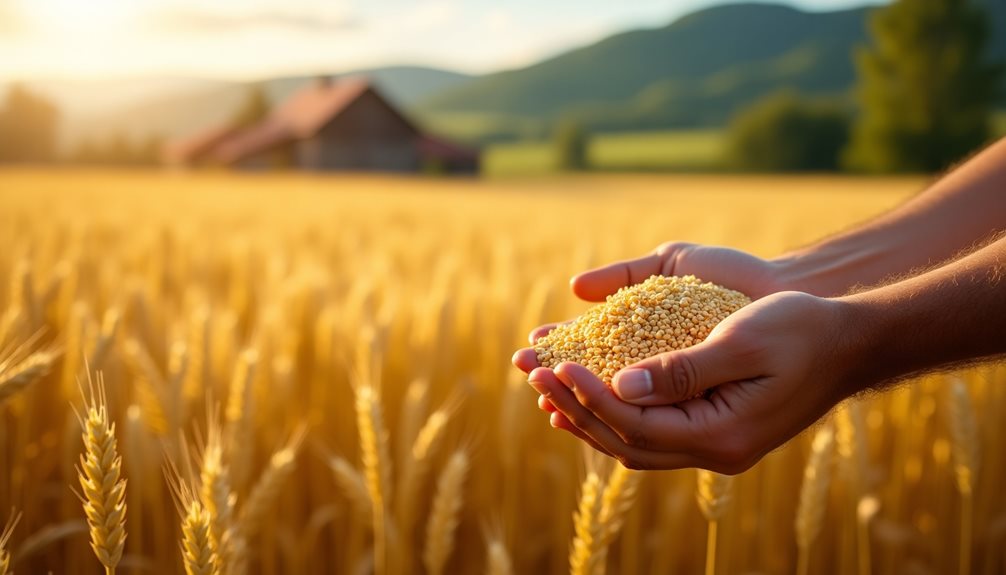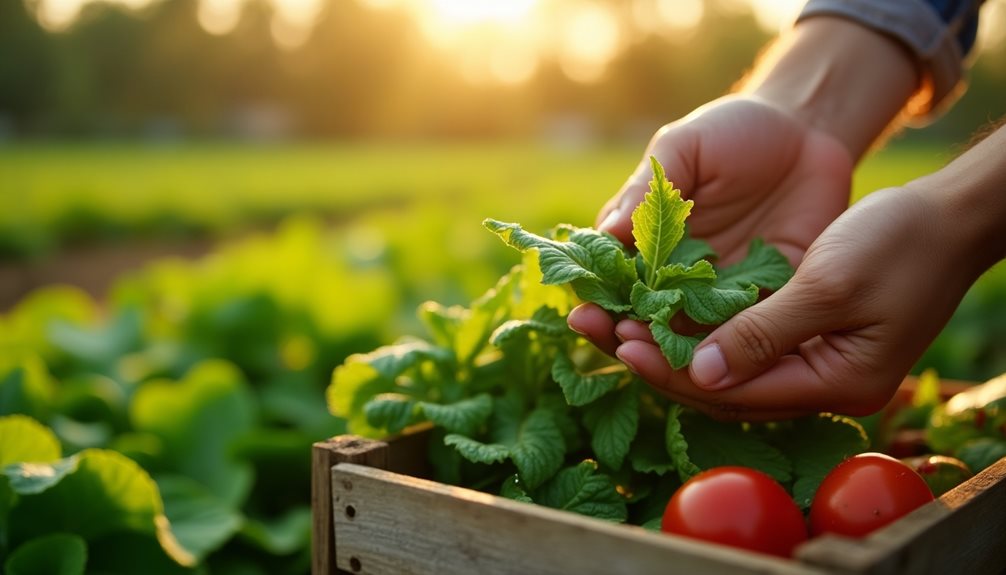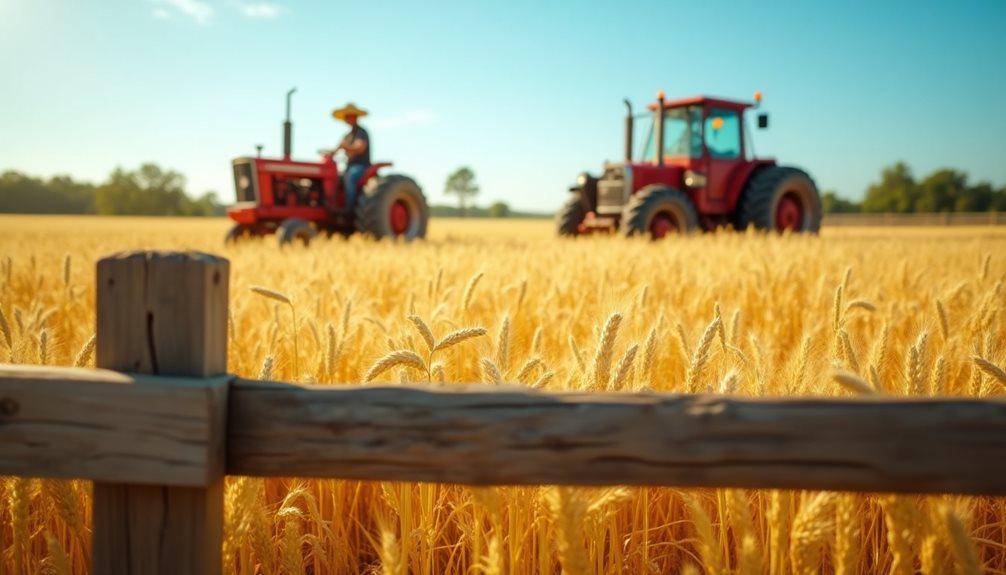Understanding agriculture and farming vocabulary in Russian is essential for effective communication in the field. Key terms such as “севооборот” and “животноводство” play a critical role in agricultural discourse. Mastery of these concepts not only aids in decision-making but also enhances collaboration among agricultural professionals. Exploring the nuances of this vocabulary can reveal deeper insights into farming practices and the broader agricultural landscape. What implications do these terms hold for modern farming approaches?
Table of Contents
ToggleEssential Crop Vocabulary

Grasping essential crop vocabulary is key to successful farming and agricultural management. Familiarity with important terms like “crop rotation” and “seed selection” helps farmers optimize their practices, improve yields, and maintain sustainable land use.
Crop rotation (севооборот) is a time-tested agricultural technique that involves the planned alternation of different crops on the same field across growing seasons. This method prevents soil depletion by balancing nutrient demands, as various crops absorb and replenish different nutrients. For example, legumes fix nitrogen in the soil, benefiting the next crop, such as cereals, which require more nitrogen. Additionally, crop rotation disrupts the life cycles of pests and diseases by removing their preferred hosts, reducing the need for chemical pesticides. It also helps control weeds naturally and improves soil structure over time, increasing water retention and aeration.
Key benefits of crop rotation include:
- Restoring soil fertility (восстановление плодородия почвы)
- Breaking pest and disease cycles (прерывание циклов вредителей и болезней)
- Enhancing biodiversity in the field (повышение биоразнообразия)
- Reducing reliance on chemical inputs (снижение зависимости от химических веществ)
Seed selection (выбор семян) plays a crucial role in successful crop production. Choosing the right seeds depends on many factors such as local climate conditions, soil type, crop purpose (whether for food, feed, or industrial use), and resistance to pests or diseases. High-quality seeds improve germination rates, plant vigor, and ultimately yield. Using certified seeds with known genetic traits helps ensure uniformity and predictability in crop growth.
Important factors in seed selection include:
- Adaptability to local climate (адаптация к местному климату)
- Resistance to prevalent pests and diseases (устойчивость к вредителям и болезням)
- Suitability for soil conditions (соответствие почвенным условиям)
- Desired crop characteristics such as size, taste, and maturation period (желаемые характеристики урожая)
Familiarity with these concepts supports better farm management and strengthens communication between farmers, agronomists, and agricultural suppliers. This knowledge promotes informed decisions that enhance productivity while preserving the environment.
In summary:
- Севооборот (Crop rotation) is essential for sustainable farming, maintaining soil health and reducing pests.
- Выбор семян (Seed selection) ensures crops are well-suited to their environment and meet production goals.
Applying these principles contributes significantly to efficient, productive, and environmentally friendly agriculture.
Livestock Terminology
Livestock terminology is crucial for effective management and communication within the agricultural industry. It encompasses various terms related to animal husbandry, including specific breeding practices and livestock nutrition. Understanding these terms enables farmers to implement ideal breeding strategies, enhancing genetic diversity and productivity.
![]()
Breeding Practices (Селекция и разведение)
Breeding is the foundation of improving livestock. It involves selecting animals with desirable traits to produce offspring with better genetics.
- Selective breeding (селекция): Choosing animals with favorable characteristics.
- Crossbreeding (скрещивание): Mating animals from different breeds to combine traits.
- Purebred (чистопородный): Animals bred from parents of the same breed.
- Genetic diversity (генетическое разнообразие): Variation in genetic traits within a population, important for healthy livestock.
Nutrition (Питание животных)
Proper nutrition ensures animals grow well, stay healthy, and produce high-quality products such as milk, meat, or wool.
- Feed types: Different kinds of feed like hay, grains, silage.
- Nutrient requirements: Proteins, carbohydrates, fats, vitamins, and minerals needed by animals.
- Dietary formulations: Balanced diets designed to meet specific nutritional needs.
Health and Productivity
Good management using proper terminology ensures the health and productivity of livestock.
- Recognizing signs of malnutrition or illness.
- Implementing feeding schedules.
- Monitoring growth rates and reproductive performance.
Related Russian Terms for Livestock Management
| Cyrillic Term | English Phonetic | English Definition |
|---|---|---|
| Скот | Skot | Livestock |
| Животное | Zhivotnoye | Animal |
| Корм | Korm | Feed |
| Питание | Pitanie | Nutrition |
| Разведение | Razvedeniye | Breeding |
| Селекция | Selektsiya | Selective breeding |
| Скрещивание | Skreshchivaniye | Crossbreeding |
| Чистопородный | Chistoporodny | Purebred |
| Генетика | Genetika | Genetics |
| Генетическое разнообразие | Geneticheskoye raznoobraziye | Genetic diversity |
| Ветеринар | Veterinar | Veterinarian |
| Заболевание | Zabolevaniye | Disease |
| Рост | Rost | Growth |
| Рацион | Ratsion | Ration/diet |
| Вода | Voda | Water |
| Удой | Udoy | Milk yield |
| Мясо | Myaso | Meat |
| Овца | Ovtsa | Sheep |
| Коза | Koza | Goat |
| Корова | Korova | Cow |
Proficiency in this specialized vocabulary empowers agricultural professionals to make informed decisions, ensuring sustainable practices and efficient resource use in livestock management. Mastery of livestock terminology ultimately contributes to the success of agricultural operations.
Farming Techniques and Practices
Farming techniques and practices are crucial for improving agricultural productivity while ensuring the long-term health of the environment. Understanding and using effective methods can make a big difference in how much food is produced and how sustainable farming can be over time.
One of the most important traditional methods is crop rotation (севооборот — sevooborot). Crop rotation means planting different types of crops in the same area across different seasons or years. This technique helps keep the soil healthy by balancing nutrient use. For example, legumes like peas or beans add nitrogen (азот — azot) to the soil, which benefits the next crop, often cereals like wheat or corn. Crop rotation also reduces the chances of pests and diseases building up in the soil, because many pests specialize in one type of plant and won’t survive if their preferred crop isn’t there every year.
In modern farming, precision farming (точное земледелие — tochnoye zemledeliye) is becoming popular. This method uses new technologies such as GPS (глобальная система позиционирования — globalnaya sistema pozitsionirovaniya) and sensors to collect detailed information about fields. Farmers use this data to make precise decisions about watering (орошение — orosheniye), fertilizing (удобрение — udobreniye), and pest control (контроль вредителей — kontrol’ vrediteley). This technology helps avoid waste by applying resources only where they are needed, which saves money and protects the environment.
Other important farming practices include:
- Conservation tillage (консервационная обработка почвы — konservatsionnaya obrabotka pochvy): Reducing how much the soil is disturbed helps keep its structure intact, preserves moisture, and prevents erosion.
- Integrated pest management (интегрированное управление вредителями — integrirovannoye upravleniye vreditelyami): Combining biological methods (like introducing natural predators) with minimal chemical use to control pests.
- Organic farming (органическое земледелие — organicheskoye zemledeliye): Avoiding synthetic chemicals and focusing on natural inputs to maintain soil fertility and biodiversity.
By combining traditional methods like crop rotation with modern approaches like precision farming, agriculture becomes more productive and sustainable. This balance helps protect natural resources while supporting farmers’ livelihoods, making sure that future generations will also have healthy soil and enough food.
These terms can be useful when discussing farming in Russian:
- Soil — почва (pochva)
- Fertilizer — удобрение (udobreniye)
- Crop — культура (kultura)
- Pest — вредитель (vreditel’)
- Yield — урожай (urozhay)
- Sustainability — устойчивость (ustoychivost’)
Understanding these concepts clarifies how farming operates in Russia and worldwide. Integrating these techniques improves efficiency while supporting sustainable practices, promoting both environmental care and economic viability in agriculture.
![]()
Agricultural Equipment and Tools
Agricultural Equipment and Tools: Enhancing Farming Efficiency
The success of modern agriculture depends heavily on the use of specialized equipment and tools designed to perform various farming tasks more efficiently. These machines not only help farmers save time and reduce manual labor but also significantly increase crop yields, which is essential to meet the growing global demand for food.
One of the most important categories of agricultural machinery is harvesting equipment. These machines include combines (комбайн, [kombáyn]), threshers (молотилка, [molotílka]), and harvesters (жатка, [zhátka]). The combine harvester is especially crucial because it merges three separate operations — reaping (срезание урожая, [srezániye urozháya]), threshing (обмолот, [obmolót]), and winnowing (веяние, [veyániye]) — into one continuous process. This integration speeds up the harvesting process dramatically and reduces the need for large numbers of workers. As a result, farmers can manage larger fields more effectively and bring in crops faster before spoilage or bad weather.
Threshers play a vital role by separating grain from stalks and husks, which is a necessary step in processing cereal crops like wheat (пшеница, [pshenítsa]), rice (рис, [ris]), and barley (ячмень, [yachmén’]). Historically, threshers were simple, manual tools or animal-driven machines. Today, they have evolved into highly automated motorized equipment capable of handling large quantities quickly and with minimal human intervention. This mechanization has helped improve productivity and reduce post-harvest losses.
Irrigation systems are another cornerstone of modern agriculture, especially in regions where rainfall is unreliable or insufficient. Proper irrigation ensures crops receive the right amount of water during critical growth stages, directly affecting both yield and quality. Traditional methods like flood irrigation (затопление, [zatopléniye]) are being replaced by more efficient technologies such as drip irrigation (капельное орошение, [kapélnoye oroshéniye]) and sprinkler systems (оросительная система, [orosítel’naya systému]).
Drip irrigation delivers water slowly and directly to the roots through a network of tubes and emitters. This method minimizes water waste by reducing evaporation and runoff while preventing soil erosion (эрозия почвы, [erozíya póchvy]). Sprinkler systems mimic natural rainfall by distributing water evenly over large fields, allowing farmers to irrigate extensive areas quickly and uniformly. Both methods conserve water and support sustainable farming practices by limiting nutrient runoff (потеря питательных веществ, [potérya pitátel’nykh veshchéstv]) and maintaining soil health.
Together, advanced harvesting machinery and irrigation systems help farmers increase productivity, cut costs, and protect the environment. These tools empower farmers to work more independently and successfully manage their agricultural enterprises, meeting the rising need for food worldwide.
Additional interesting facts:
- Modern combines can harvest hundreds of acres per day, often equipped with GPS technology (спутниковая навигация, [sputnikováya navigátsiya]) to guide their movement precisely.
- Drip irrigation was first developed in Israel and is now widely used in water-scarce regions like parts of Africa and the Middle East.
- Some threshers combine both threshing and cleaning functions to deliver ready-to-store grain directly after harvest.
- The development of electric and solar-powered irrigation pumps is increasing the accessibility of irrigation in remote areas.
This combination of high-tech equipment and smart water management is transforming agriculture into a more productive, sustainable industry worldwide.
Soil and Fertility Terms
Understanding soil and fertility is very important for farming and gardening. In Russian, some key words and ideas help English speakers learn how to talk about these topics clearly.
Key Elements Include:
Soil Quality — Качество Почвы (Kachestvo Pochvy)
Soil quality means how good the soil is for growing plants. Good soil has the right balance of water, air, minerals, and organic matter. The better the soil quality, the healthier the crops.
Fertility — Плодородие (Plodorodiye)
Fertility means how well the soil can supply nutrients to plants. Fertile soil contains enough nutrients like nitrogen, phosphorus, and potassium for strong plant growth.
Organic Matter — Органическое Вещество (Organicheskoye Veshchestvo)
This is material from dead plants and animals that decomposes in the soil. It improves soil structure and helps hold moisture and nutrients.
Minerals — Минералы (Mineraly)
Minerals in the soil come from rocks and are important nutrients for plants. Examples include nitrogen (азот), phosphorus (фосфор), and potassium (калий).
Moisture Content — Влажность Почвы (Vlaghnost’ Pochvy)
This means how much water is in the soil. Plants need enough water, but not too much. Good moisture helps nutrients move through the soil.
Fertility Enhancement Techniques — Методы Улучшения Плодородия
- Crop Rotation — Севооборот (Sevooborot): Planting different crops in a planned order to keep soil healthy.
- Cover Cropping — Покровные Культуры (Pokrovnyye Kultury): Growing crops that protect and enrich the soil.
- Organic Fertilizers — Органические Удобрения (Organicheskiye Udobreniya): Natural materials like compost or manure added to the soil to increase nutrients.
Soil Testing — Анализ Почвы (Analiz Pochvy)
Farmers test soil to measure nutrient levels and pH (how acidic or basic the soil is). This helps them decide what fertilizers to use for best crop growth.
Useful Russian Vocabulary Table
| Russian (Cyrillic) | English Phonetic | English Definition |
|---|---|---|
| Почва | Pochva | Soil |
| Плодородие | Plodorodiye | Fertility |
| Органическое вещество | Organicheskoye veshchestvo | Organic matter |
| Минералы | Mineraly | Minerals |
| Влажность почвы | Vlaghnost’ pochvy | Moisture content |
| Азот | Azot | Nitrogen (a key nutrient) |
| Фосфор | Fosfor | Phosphorus (a key nutrient) |
| Калий | Kaliy | Potassium (a key nutrient) |
| Севооборот | Sevooborot | Crop rotation |
| Покровные культуры | Pokrovnyye kultury | Cover crops |
| Органические удобрения | Organicheskiye udobreniya | Organic fertilizers |
| Анализ почвы | Analiz pochvy | Soil testing |
| pH почвы | pH pochvy | Soil pH (acidity/basic level) |
This expanded vocabulary helps English speakers confidently understand and discuss soil and fertility in Russian.
Additionally, soil testing plays a crucial role in assessing nutrient levels and pH balance, enabling farmers to make informed decisions for optimal crop yields.
Pest and Disease Management

Effective management of pests and diseases is essential for maintaining healthy crops and ensuring agricultural productivity. A critical foundation of this process is soil management (управление почвой / upravleniye pochvoy). Healthy soil, rich in nutrients and well-structured, promotes vigorous plant growth, making plants more resistant to pests and diseases. For instance, soils high in organic matter (органическое вещество / organicheskoye veshchestvo) improve water retention (удержание влаги / uderzhaniye vlagi) and nutrient availability (доступность питательных веществ / dostupnost pitatelnykh veshchestv), which strengthens plant immune responses and overall resilience.
Disease Identification and Early Intervention (Распознавание болезней и раннее вмешательство / raspoznavaniye bolezney i ranneye vmeshatelstvo)
Early detection of plant diseases (растительные болезни / rastitel’nyye bolezni) is vital to prevent large-scale crop damage. Farmers need to recognize symptoms such as:
- Leaf spots (пятна на листьях / pyatna na list’yakh)
- Wilting (увядание / uvyanie)
- Discoloration (обесцвечивание / obestsvechivaniye)
- Unusual growth patterns (аномалии роста / anomalii rosta)
Diseases often originate from fungi (грибы / griby), bacteria (бактерии / bakterii), viruses (вирусы / virusy), or nematodes (нематоды / nematody), each requiring different management strategies. Early diagnosis enables targeted treatments, reducing the need for widespread pesticide use and minimizing environmental impact.
Responsible Use of Pesticides (Ответственное использование пестицидов / otvetstvennoye ispol’zovaniye pesticidov)
Pesticides (пестициды / pesticidy) play a significant role in controlling pests but must be used judiciously to avoid problems like:
- Development of pesticide resistance (устойчивость к пестицидам / ustoychivost k pesticidam) in pest populations
- Environmental contamination (загрязнение окружающей среды / zagryazneniye okruzhayushchey sredy)
- Harm to beneficial insects such as pollinators (опылители / opyliteli) and natural predators (естественные враги / yestestvennyye vragi)
Best practices include following label instructions carefully, applying pesticides only when pest levels exceed economic thresholds, using the correct dosage, and selecting products with minimal environmental risks.
Integrated Pest Management (IPM) — Интегрированное управление вредителями (IPM) / integrirovannoye upravleniye vreditelyami
IPM is a comprehensive strategy that combines multiple methods to sustainably control pest populations while protecting the environment. Key components of IPM include:
- Monitoring (мониторинг / monitoring): Regular scouting to assess pest density and identify species.
- Biological controls (биологический контроль / biologicheskiy kontrol): Utilizing natural enemies such as predatory insects (хищные насекомые / khishchnyye nasekomye), parasitoids (паразитоиды / parazitoidy), and microbial agents (микробные агенты / mikrobnyye agenty).
- Cultural practices (агротехнические приемы / agrotekhnicheskiye priemy): Crop rotation (севооборот / sevooborot), intercropping (смешанные посевы / smeshannyye posevy), planting resistant varieties (устойчивые сорта / ustoychivyye sorta), and sanitation measures (санитария / sanitarija) to interrupt pest life cycles.
- Chemical controls (химические методы / khimicheskiye metody): Applying pesticides only as a last resort in targeted ways to minimize negative impacts.
This method reduces reliance on chemicals, supports biodiversity, and maintains crop health.
Understanding Pest Life Cycles and Disease Dynamics (Понимание жизненных циклов вредителей и динамики болезней / ponimaniye zhiznennykh tsiklov vrediteley i dinamiki bolezney)
Knowing the biology and life cycles of pests allows farmers to apply control measures at the most vulnerable stages, such as eggs or larvae, increasing effectiveness. Staying informed about emerging diseases—often influenced by climate change (изменение климата / izmeneniye klimata) and global trade—is crucial for timely response and prevention.
Summary of Key Practices for Sustainable Pest and Disease Management
- Maintain soil health with balanced nutrients and organic matter.
- Conduct regular field inspections to detect early signs of disease or pest infestation.
- Use pesticides responsibly, adhering strictly to guidelines.
- Employ IPM strategies combining biological, cultural, and chemical controls.
- Educate yourself on pest biology and emerging threats.
Sustainable pest and disease management benefits farmers by enhancing crop vitality, reducing financial losses, protecting ecosystems, and ensuring long-term agricultural success.
Russian Keywords and Phrases
- Pest management – управление вредителями (upravleniye vreditelyami)
- Disease management – управление болезнями (upravleniye boleznyami)
- Soil health – здоровье почвы (zdorov’ye pochvy)
- Organic matter – органическое вещество (organicheskoye veshchestvo)
- Water retention – удержание влаги (uderzhaniye vlagi)
- Nutrient availability – доступность питательных веществ (dostupnost pitatelnykh veshchestv)
- Leaf spots – пятна на листьях (pyatna na list’yakh)
- Wilting – увядание (uvyanie)
- Discoloration – обесцвечивание (obestsvechivaniye)
- Fungi – грибы (griby)
- Bacteria – бактерии (bakterii)
- Viruses – вирусы (virusy)
- Nematodes – нематоды (nematody)
- Pesticides – пестициды (pesticidy)
- Resistance – устойчивость к пестицидам (ustoychivost k pesticidam)
- Environmental contamination – загрязнение окружающей среды (zagryazneniye okruzhayushchey sredy)
- Pollinators – опылители (opyliteli)
- Natural predators – естественные враги (yestestvennyye vragi)
- Monitoring – мониторинг (monitoring)
- Biological control – биологический контроль (biologicheskiy kontrol)
- Crop rotation – севооборот (sevooborot)
- Intercropping – смешанные посевы (smeshannyye posevy)
- Resistant varieties – устойчивые сорта (ustoychivyye sorta)
- Sanitation – санитария (sanitarija)
- Integrated Pest Management (IPM) – интегрированное управление вредителями (IPM) (integrirovannoye upravleniye vreditelyami)
![]()
Sustainable Agriculture Concepts
Sustainable agriculture is a way of farming that focuses on balancing three main areas: protecting the environment, supporting farmers and local communities, and making sure farming can continue for many years without harming the land.
Key Concepts
Organic Farming / Органическое земледелие
Organic farming avoids synthetic chemicals like artificial fertilizers and pesticides. Instead, it uses natural materials such as compost, manure, and biological pest control. This helps keep the soil healthy and encourages a variety of plants and animals to live on the farm.
Example: A farm that grows vegetables without chemical pesticides but uses crop rotation and natural pest predators.
Regenerative Practices / Регенеративные практики
Regenerative agriculture goes a step further by not only avoiding harm but actively improving the land. Techniques include:
- Cover cropping (Посев покровных культур): Planting special crops like clover or rye during off-seasons to protect and enrich the soil.
- Agroforestry (Агролесоводство): Combining trees with crops or livestock to improve biodiversity and reduce erosion.
- Carbon sequestration (Удержание углерода): Capturing carbon dioxide from the air and storing it in plants and soil, which helps fight climate change.
Social and Economic Benefits
Sustainable agriculture supports local economies by creating jobs and encouraging local food markets. It also empowers farmers through education and cooperative activities that build stronger communities.
Goal of Sustainable Agriculture
The ultimate goal is to produce enough food to meet today’s needs while making sure future generations can also have healthy soil, clean water, and a stable climate.
Related Russian Terms for Sustainable Agriculture
| Cyrillic | English Phonetic | English Definition |
|---|---|---|
| устойчивое сельское хозяйство | ustoychivoye selskoye khozyaystvo | sustainable agriculture |
| органическое земледелие | organicheskoye zemledeliye | organic farming |
| регенеративные практики | regenerativnye praktiki | regenerative practices |
| посев покровных культур | posev pokrovnykh kultur | cover cropping |
| агролесоводство | agrolesovodstvo | agroforestry |
| удержание углерода | uderzhaniye ugleroda | carbon sequestration |
| биоразнообразие | bioraznoobrazie | biodiversity |
| почвенное здоровье | pochvennoye zdorovye | soil health |
| местная экономика | mestnaya ekonomiia | local economy |
| равенство в обществе | ravenstvo v obshchestve | social equity |
| экологическая устойчивость | ekologicheskaya ustoychivost | ecological sustainability |
This list includes key terms in Russian that are essential for understanding sustainable agriculture, especially for learners interested in environmental and agricultural topics.
Sustainable agriculture combines these methods to build a productive and fair food system that meets current needs while ensuring future generations can also thrive.
Together, these concepts reflect a holistic approach to farming that balances agricultural practices with ecological health.
Agricultural Trade and Economics
Sustainable agricultural practices are essential for preserving the environment and have a major influence on global agricultural trade and economics. When countries use farming methods that protect natural resources and reduce harm to the environment, they improve the quality and reputation of their agricultural products. This improvement helps them compete better in international markets.
Consumers around the world are becoming more aware of how food is produced. They prefer products that are ethically sourced and environmentally safe. Because of this, sustainably produced agricultural goods often sell at higher prices. This demand has led to the growth of special markets for organic (органический — [organicheskiy]), fair-trade (справедливая торговля — [spravedlivaya torgovlya]), and sustainably certified (устойчиво сертифицированный — [ustoychivo sertifitsirovannyy]) products. For example, the global market for organic food alone was valued at over $120 billion in recent years and continues to grow quickly, showing how important sustainability is becoming in food trade.
Sustainable agriculture also reduces risks caused by climate change, such as floods, droughts, and soil erosion (эрозия почвы — [eroziya pochvy]). These problems can damage crops and disrupt food supply chains, making it hard to maintain steady exports. By using techniques like crop diversification (разнообразие культур — [raznoobrazie kultur]), conserving water (сохранение воды — [sokhranenie vody]), reducing chemical fertilizers and pesticides (уменьшение использования химикатов — [umenshenie ispolzovaniya khimikátov]), and managing soil health (управление здоровьем почвы — [upravlenie zdorovyem pochvy]), farmers can protect their land from damage and keep production stable. This stability is vital for reliable trade partnerships and consistent export volumes.
Looking ahead, sustainable agriculture is crucial because global food demand is expected to rise by 50% by 2050 due to population growth and changes in diets. Countries that adopt sustainable farming methods will be better prepared to meet this demand. These practices help reduce costs by lowering the need for expensive inputs like chemical fertilizers and water, improve yield stability (стабильность урожая — [stabilnost urozhaya]), and encourage innovation in farming technologies (инновации в сельском хозяйстве — [innovatsii v selskóm khozyaystve]).
International trade policies are also changing to support sustainability goals. Many trade agreements now include rules that promote environmental protection (защита окружающей среды — [zashchita okruzhayushchey sredy]) and responsible use of resources (ответственное использование ресурсов — [otvetstvennoye ispolzovaniye resursov]). These policies encourage countries to adopt greener farming techniques, which helps balance economic growth with care for the planet.
In sum, the connection between agricultural trade and economics shows the world’s growing commitment to protecting the environment while ensuring food security (продовольственная безопасность — [prodovolstvennaya bezopasnost]) and economic strength. Sustainable agriculture supports healthier ecosystems, opens new market opportunities, and builds economic resilience (экономическая устойчивость — [ekonomicheskaya ustoychivost]) for countries involved in global trade.
Key points about sustainable agriculture and trade include:
- Higher product value: Sustainable products often sell at premium prices due to consumer demand for ethical and eco-friendly goods.
- Risk reduction: Practices like crop diversification and soil management help farmers withstand climate challenges.
- Long-term food security: Sustainable farming supports stable food supplies despite population growth.
- Economic benefits: Lower input costs and innovation lead to more profitable farming.
- Policy support: Trade agreements increasingly require environmental responsibility.
- Market growth: Organic and certified sustainable foods are expanding rapidly worldwide.
This approach strengthens both the environment and the economies of countries that engage in global agricultural trade.
Frequently Asked Questions
What Are Common Agricultural Terms in Everyday Russian Conversation?
In everyday Russian conversations about agriculture, some common terms you might hear include “farm machinery” and “crop rotation,” which are important for talking about modern farming methods that focus on efficiency and sustainability. For example, “farm machinery” in Russian is сельскохозяйственная техника (pronounced selskokhozyaystvennaya tekhnika). This term refers to all kinds of machines used on farms, like tractors and harvesters. Another important term is “crop rotation,” which in Russian is севооборот (sevooborot). Crop rotation means changing the types of crops planted in a particular field over time to keep the soil healthy. Additionally, you might hear удобрения (udobreniya), which means “fertilizers,” substances added to soil to help plants grow better. These terms are commonly used when discussing farming practices in Russia and help people understand the key ideas behind sustainable agriculture.
How Can I Improve My Agricultural Vocabulary in Russian?
To improve your agricultural vocabulary in Russian, you can use vocabulary flashcards and include agricultural slang. For example, farmers sometimes use the slang word “урожай” (urozhay) meaning “harvest,” or “трактор” (traktor), which means “tractor” but can also be used informally to describe someone who works very hard. Engaging with native speakers and consuming media related to agriculture, like videos or articles, will help you better understand and remember specialized terms.
Are There Regional Variations in Agricultural Terminology in Russia?
Regional variations in agricultural terminology exist throughout Russia, influenced by local dialects and specific agricultural practices. These differences reflect the diverse climatic conditions and cultural influences present across various regions, impacting communication among agricultural communities.
How Is Agriculture Vocabulary Used in Russian Literature?
Agricultural vocabulary in Russian literature frequently functions as a tool for symbolism, reflecting the close relationship between people and the land. These terms often highlight themes of nature, growth, and human endurance amid hardship. For example, the word пахать (pahat’), meaning “to plow,” can symbolize hard work and preparation for future growth, while жать (zhat’), meaning “to reap,” often represents the results of one’s efforts or fate. Such vocabulary enriches the emotional depth and cultural background of stories by connecting characters’ lives to the cycles of nature and rural traditions.



